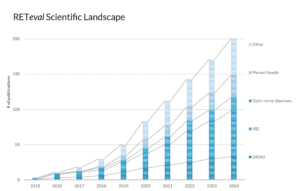Major Milestone:
RETeval Referenced in 200 Publications
LKC Technologies is excited to share a significant milestone for the RETeval® handheld ERG/VEP device – it has been referenced in more than 200 publications! This achievement underscores the growing recognition of RETeval as a valuable aid in the diagnosis and management of retina and optic nerve diseases.
In the past six months alone, numerous studies have been published, highlighting the diverse applications of RETeval in advancing patient care. From innovative diabetes assessments to pediatric myopia and vigabatrin toxicity assessment, RETeval continues to demonstrate its versatility and clinical utility.

Check out publications that highlight RETeval and how it’s improving clinical care for patients around the world:
New Approach on Diabetes Assessments
While we are used to ERG using light to stimulate the retinal cells, a recent series of papers by Dr. Stephanie Thebault’s group (National University of Mexico, Mexico) explores another concept using spontaneous retinal oscillations. In this approach, the spontaneous electrical activities of the retinal cells are measured and said to be a biomarker for metabolic health. In two studies they lay out the basic principle, demonstrate feasibility in animal models, and examine its potential for detecting diabetic macular edema in cases of diabetic retinopathy. Another study investigates whether these oscillations can predict early risk factors for type 2 diabetes, aiming to establish an effective, large-scale screening method.
Their goal? To enable personalized preventive actions against this global health burden even in fields beyond ophthalmology.
We invite you to read about these new possibilities for ERG technology and preventive healthcare:
- Noguez Imm R, Muñoz-Benitez J, Medina D, et al. Preventable risk factors for type 2 diabetes can be detected using noninvasive spontaneous electroretinogram signals. Barnes S, ed. PLoS ONE. 2023;18(1):e0278388. doi:10.1371/journal.pone.0278388
- Rodríguez-Arzate CA, Noguez-Imm R, Reyes-Ortega P, et al. Potential contributions of the intrinsic retinal oscillations recording using non-invasive electroretinogram to bioelectronics. Frontiers in Cellular Neuroscience. 2024;17:1224558. doi:10.3389/fncel.2023.1224558
- Hughes-Cano JA, Quiroz-Mercado H, Hernández-Zimbrón LF, et al. Improved predictive diagnosis of diabetic macular edema based on hybrid models: An observational study. Computers in Biology and Medicine. 2024;170:107979. doi:10.1016/j.compbiomed.2024.107979
Explore all research publications on the use of RETeval in managing diabetic retinopathy >
Myopia in X-linked Retinopathies, Pediatric
Back in 2021, LKC Technologies hosted a fascinating webinar about the connection between high myopia in children and the presence of inherited retinal degenerations by Dr. Xiaoian Ding (Sun Yat-Sen University, China). Her group analyzed the link between high myopia and X-linked retinopathies in an East Asian population and found myopia in 88% of the children with X-linked Retinopathies. The study emphasizes the importance of considering inherited retinal disease in early-onset high myopia cases, even without other symptoms or family history. Detecting these conditions early is crucial, and an easy-to-use ERG device is essential for accurate diagnosis and monitoring.
- Huang L, Lai Y, Sun L, Li S, Ding X. High myopia is common in patients with x-linked retinopathies: Myopic Maculopathy Analysis. Retina. 2024;44(1):117. doi:10.1097/IAE.0000000000003934
Explore all research publications on the use of RETeval in pediatric ophthalmology >
Vigabatrin Toxicity Assessment, Pediatric
Having a child diagnosed with infantile spasms is a challenging and frightening experience for families. Vigabatrin, a recently approved treatment in India, offers hope, but it also carries risks of retinal toxicity leading to visual field loss, with predicted frequencies ranging from 14% to 92%. Since visual field tests are often impractical for young children, the electroretinogram (ERG) is recommended as a primary screening tool for patients aged 2 years or younger.
In their study, Nagarajan et al. discovered that 72.7% of children exhibited vigabatrin-induced retinal toxicity when tested using a rapid and convenient flicker ERG test with RETeval. They concluded that the “30-Hz flicker ERG can serve as a screening tool to monitor and detect early retinal changes caused by vigabatrin, helping to prevent visual loss in children.”
- Nagarajan S, Prabu R, Parachuri N, Thulasidas M. Electroretinogram as a Screening Tool to Assess Vigabatrin-Induced Retinal Toxicity in Children With Infantile Spasms. Journal of Pediatric Ophthalmology & Strabismus. Published online March 14, 2024:1-6. doi:10.3928/01913913-20240215-01
Explore all research publications on the use of RETeval in pediatric ophthalmology >
Mini Review on RETeval
Discover the latest ERG technology insights with a comprehensive review by Dr. Amr Saad and his colleagues (Heinrich Heine University Düsseldorf, Germany). This study explores RETeval‘s reliability, quality, and clinical utility in conditions like diabetic retinopathy, glaucoma, and retinopathy of prematurity (ROP).
The study also suggests a strong correlation between ERG and the central nervous system, providing valuable insights into potential biomarkers in a non-ophthalmologic field. Notably, the research concludes by outlining the possible use of portable ERG within the oculomics framework to assess general health of a patient and thus emphasizing its role in advancing population-wide health initiatives.
Dive into this review to discover the future of ERG research and oculomics projects:
- Saad A, Turgut F, Sommer C, et al. The Use of the RETeval Portable Electroretinography Device for Low-Cost Screening: A Mini-Review. Klin Monbl Augenheilkd. 2024;241(04):533-537. doi:10.1055/a-2237-3814
Mental Health
Over the past three months, RETeval has been featured in multiple publications exploring its potential in cognitive and mental health research.
The retina, evolutionarily linked to the brain, offers unique insights. Explore recent studies like Dr. Manjur’s (Mississippi State University, USA), Dr. Kulyabin’s (University of Erlangen–Nuremberg, Germany), and Dr. Huang’s (King’s College London, United Kingdom) about the use of ERG with RETeval in autism spectrum disorder (#ASD) and ADHD diagnostics:
- Manjur SM, Diaz LRM, Lee IO, et al. Detecting Autism Spectrum Disorder and Attention Deficit Hyperactivity Disorder Using Multimodal Time-Frequency Analysis with Machine Learning Using the Electroretinogram from Two Flash Strengths. Journal of Autism and Developmental Disorders. 2024 Feb 23. doi: 10.1007/s10803-024-06290-w
- Kulyabin M, Constable PA, Zhdanov A, et al. Attention to the Electroretinogram: Gated Multilayer Perceptron for ASD Classification. IEEE Access. Volume 12, pp. 52352-52362, 2024, doi: 10.1109/ACCESS.2024.3386638
- Huang Q, Ellis CL, Leo SM, et al. Retinal GABAergic Alterations in Adults with Autism Spectrum Disorder. Journal of Neuroscience. 3 April 2024, 44 (14) e1218232024; doi: 10.1523/JNEUROSCI.1218-23.2024
Another interesting approach is the work by Dr. Silverstein (University of Rochester Medical Center, USA) about the investigation of retinal electrophysiology biomarkers in subconcussive head hits or Dr. Velez-Perez’s (Beth Israel Deaconess Medical Center, USA) insights into retinal changes in early-course psychosis:
- Silverstein SM, Atlas J, Young M, et al. Football-Related Concussions and Head Impacts are Associated with Changes in Retinal Structure and Signaling. Biomarkers in Neuropsychiatry. Volume 10, June 2024, 100091. doi: 10.1016/j.bionps.2024.100091
- Velez-Perez E, Raymond N, Kiely C, et al. Electroretinographic dysfunction, insulin resistance, and childhood trauma in early-course psychosis: A case-control exploratory study. Biomarkers in Neuropsychiatry. Volume 10, 2024, 100088, doi: 10.1016/j.bionps.2024.100088
Notably, the team at University Hospital of Munich (LMU, Germany) just published and extensive study highlighting electrophysiology biomarkers in schizophrenia spectrum disorders (SSD) and “uncovered distinct electrophysiological alterations, i.e., lower a- and b wave amplitudes in SSD, indicating reduced photoreceptor and bipolar cell responses to light stimuli in SSD.”:
- Boudriot E, Gabriel V, Popovic D, et al. Signature of altered retinal microstructures and electrophysiology in schizophrenia spectrum disorders is associated with disease severity and polygenic risk. Biological Psychiatry. 2024 Apr 26:S0006-3223(24)01262-9. doi: 10.1016/j.biopsych.2024.04.014
RETeval makes these investigations accessible with its user-friendly design, unveiling new dimensions of brain health exploration!
These publications highlight the advancements made possible with the RETeval device and its impact on ophthalmic research and clinical practice. Together, we are driving innovation in ophthalmology and improving patient outcomes worldwide.
